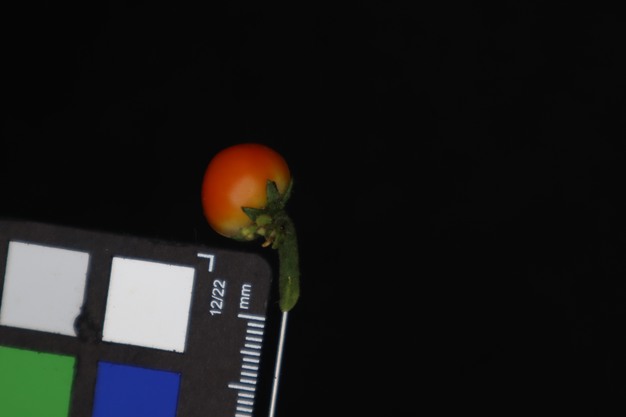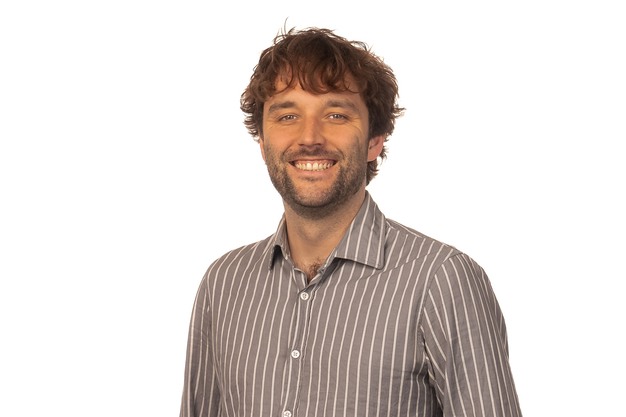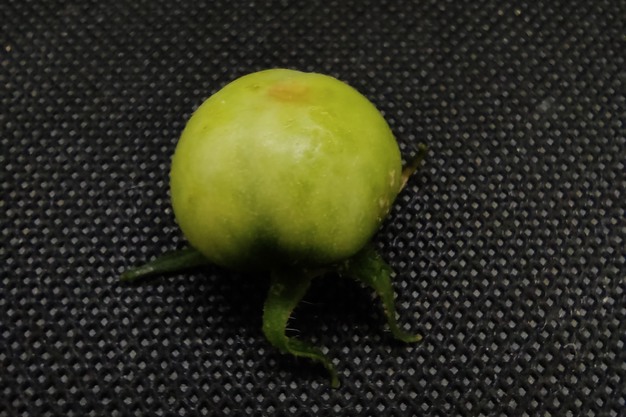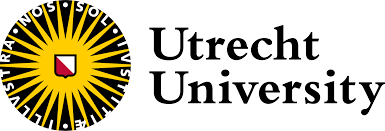In the race to optimize indoor farming, much of the industry's innovation has been focused on improving artificial lighting with more efficient LEDs, smarter sensors, and finer-tuned spectra. What if the real breakthrough isn't brighter light, but rather, no light at all?
That's the radical proposition behind Fruit of Knowledge, a research project at Wageningen University and Utrecht University that aims to grow tomatoes without photosynthesis. Instead of using plants to convert sunlight into sugars, PhD candidate Lucas van der Zee is growing tomatoes directly from flowers, feeding them external sugars in a controlled environment. The result? Fruit production without roots, soil, or the vegetative phase, and without turning electricity into light just to simulate the sun. © Niels Peeters
© Niels Peeters
A tomato grown entirely in vitro without photosynthesis, using external sugar and no light. Photo courtesy of Niels Peeters.
Beyond the plant's design logic
Photosynthesis has long been treated as the starting point for all agricultural systems, including those indoors. But van der Zee's research questions whether that dependency still makes sense, especially in controlled environments where lighting can account for more than half of total energy use. "We basically rely on photosynthesis for all primary production of biomass on earth," he says. "What if we can't rely on it anymore because climate change makes it impossible to do agriculture through drought, flooding, and storms?"
"From an energy point of view, growing crops with artificial light often doesn't make sense," van der Zee adds. "You're turning sunlight into electricity, which you then have to turn back into light, which the plant then uses to make sugars. There are so many losses along this path."
That energy inefficiency becomes especially pronounced in fruit crops like tomatoes, which demand long growth cycles, structural support, and substantial inputs. Van der Zee's approach aims to cut out the entire photosynthetic process and deliver sugars directly to the part of the plant we actually use. "If we can feed sugars directly to the growing fruit, this could open vertical farming to a whole new range of crops," he explains. "Of course, it only works if you can source those sugars sustainably."
Rethinking the plant
The project doesn't just aim to optimize energy, it seeks to rethink what a plant is for. In the lab beneath Wageningen's Radix building, van der Zee and his collaborator Niels Peeters have found ways to induce flowers from meristem cells (the stem cells of the plant) without first growing the full vegetative structure. "We are bypassing root formation and the vegetative phase entirely," says van der Zee. "The meristem generates a flower or truss of flowers instead of a plantlet. From there, we feed it nutrients and sugars directly."
Once pollinated or chemically stimulated, these flowers begin to swell into fruit. Placed in a sugar-and-nutrient medium under sterile conditions, the fruit grows independently, without photosynthesis, without light. The process mimics how seeds in a fruit drive development from within, allowing for relatively autonomous growth. "The fruit behaves completely independently once development begins. It's like tricking nature into skipping its usual steps." © Lucas van der Zee
© Lucas van der Zee
Lucas van der Zee
The energy equation
Van der Zee is currently using standard table sugar derived from sugar beets, but future iterations may rely on circular or electro-derived sources. He points to research by the Jinkerson Lab showing that electrochemical conversion of CO₂ into acetate, a carbon source some plants can use, is already more energy-efficient than photosynthesis. "If you produce sugars from electricity directly, the system becomes several times more efficient than LED-driven photosynthesis," van der Zee says. "And you avoid the need to engineer entire plant systems just to harvest the part you want."
In controlled environments where lighting accounts for up to 60% of energy costs, that shift could be transformative. A light-free model not only reduces energy demand but simplifies infrastructure, especially in climates where energy or cooling costs are prohibitive. "Other than sugar, your main inputs are nutrients and some basic mechanical systems like pumps, fans, and maybe low-grade heating. Nothing close to what full plant growth requires."
A system still in progress
The project is still in its early stages. Fruits grown so far are small, roughly the size of a blueberry, but they taste like tomatoes. Van der Zee is exploring ways to increase fruit size, including harvesting with a piece of the main stem attached to improve nutrient uptake. "We've already shown that if we leave part of the stem, the fruit can grow as large or larger than on the plant. Without it, they stay small. We're still testing why."
Even without answers yet, the implications are clear: If fruit can be grown without light, soil, or a full plant, the energy profile of vertical farming could change entirely. And with climate disruption threatening outdoor agriculture, the need for ultra-resilient, resource-lean systems has never been greater. © Lucas van der Zee One of several tomatoes grown without photosynthesis in a sugar-fed medium. Fruits currently remain small, but researchers are exploring ways to boost growth and quality.
© Lucas van der Zee One of several tomatoes grown without photosynthesis in a sugar-fed medium. Fruits currently remain small, but researchers are exploring ways to boost growth and quality.
Beyond the greenhouse
The Fruit of Knowledge team isn't positioning their work as a replacement for traditional agriculture, but as a complement, especially in contexts where growing fruit is difficult, seasonal, or expensive. "Like vertical farming, this system is climate-independent and can operate year-round. It might make the most sense for crops that are hard to grow in indoor farms today, or fruits that are fragile and have short shelf lives."
And while the idea of growing tomatoes in a jar of sugar water may sound futuristic, van der Zee is quick to ground it in practicality. In some ways, the leap is less about science fiction and more about acknowledging where our current systems fall short. "We're not trying to recreate nature," he says. "We're asking: what's the minimum we need to grow high-quality food? What happens if we design for that instead?"
For more information:
Wageningen University & Research
Lucas van der Zee
[email protected]
Utrecht University
Niels Peeters
[email protected]










